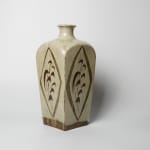Shimaoka Tatsuzo 島岡達三 1919-2007
Jar with white slip and grass carving 刷毛目唐草文壺
Stoneware
H12 5/8 × Dia 5 1/2 in.
H32 × Dia 14 cm
H32 × Dia 14 cm
With signed wood box
Further images
-
(View a larger image of thumbnail 1
)

-
(View a larger image of thumbnail 2
)

-
(View a larger image of thumbnail 3
)

-
(View a larger image of thumbnail 4
)

-
(View a larger image of thumbnail 5
)

-
(View a larger image of thumbnail 6
)

-
(View a larger image of thumbnail 7
)

-
(View a larger image of thumbnail 8
)

-
(View a larger image of thumbnail 9
)

-
(View a larger image of thumbnail 10
)

-
(View a larger image of thumbnail 11
)

-
(View a larger image of thumbnail 12
)

-
(View a larger image of thumbnail 13
)

Shimaoka Tatsuzo was a Living National Treasure known for his unique and personalized blend of Mingei and modern influences. Born in Tokyo, Shimaoka was the son of a braid and...
Shimaoka Tatsuzo was a Living National Treasure known for his unique and personalized blend of Mingei and modern influences. Born in Tokyo, Shimaoka was the son of a braid and cord maker. After a trip to the Kyoto Folk Craft Museum, he was inspired to pursue pottery at the Tokyo Institute of Technology. He was a pupil of the Mingei master Hamada Shoji, and a close associate of Yanagi Soetsu, both of whom introduced him to the techniques and traditions of Japanese pottery. He was also affiliated with Bernard Leach, after having traveled to Britain on multiple occasions; Shimaoka’s influence on the international folk craft movement is palpable.
The onset of the Second World War interrupted his practice as a craftsman. Only after returning to his work in 1946 did his ceramics tackle more complex art historical techniques. Namely, Shimaoka was deeply influenced by the Jomon period of Japanese history, known for its distinctive pottery with intricate patterns and designs. After having studied with an archaeologist on Jomon artifacts, he subsequently incorporated Jomon-esque motifs into his work, but adapted it to his own processes by incorporating the use of cords and braids to replicate the decorative surfaces of Jomon ceramics. He utilized different types of wood ash glaze to bring out the rope patterns. In 1954, built his own Nobori-Gama (wood-fired climbing kiln) in Mashiko to hone these techniques.
Shimaoka was also influenced by Western developments in Modern art aesthetics. He was inspired by the compositions of Henri Matisse, whose graphic abstract patterning can be seen on the surfaces of Shimaoka’s surface designs. Shimaoka was designated the title of Living National Treasure in 1966 for his innovation within Mingei and the Mashiko pottery scene.
The onset of the Second World War interrupted his practice as a craftsman. Only after returning to his work in 1946 did his ceramics tackle more complex art historical techniques. Namely, Shimaoka was deeply influenced by the Jomon period of Japanese history, known for its distinctive pottery with intricate patterns and designs. After having studied with an archaeologist on Jomon artifacts, he subsequently incorporated Jomon-esque motifs into his work, but adapted it to his own processes by incorporating the use of cords and braids to replicate the decorative surfaces of Jomon ceramics. He utilized different types of wood ash glaze to bring out the rope patterns. In 1954, built his own Nobori-Gama (wood-fired climbing kiln) in Mashiko to hone these techniques.
Shimaoka was also influenced by Western developments in Modern art aesthetics. He was inspired by the compositions of Henri Matisse, whose graphic abstract patterning can be seen on the surfaces of Shimaoka’s surface designs. Shimaoka was designated the title of Living National Treasure in 1966 for his innovation within Mingei and the Mashiko pottery scene.












